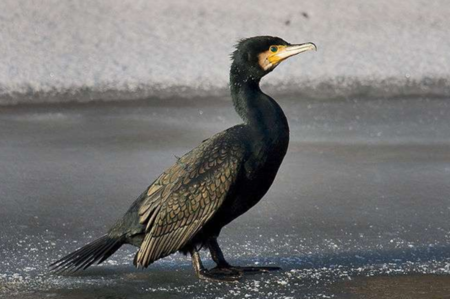Phalacrocorax carbo
sinensis
Family: Phalacrocoracidae
Length: 77 – 100 cm
Wingspan: 121 – 160 cm
Weight: 2000 – 3700 g

Identification
Appearance: large black bird with bluish and greenish metallic reflection. Long thick neck and powerful bill. Bare yellow skin at the base of the lower mandible surrounded by white. White neck during breeding season.
Distinguishing characteristics: larger than the Mediterranean shag, with no crest.
Flight: similar to geese, with the neck stretched out.
Sound: guttural calls in colonies and dormitories; usually silent the rest of the time.
Ecology and habitat
Nest: a pile of branches on a large tree or on rocks that may be decorated with algae, grass, feathers, but also marine plastic debris.
Diet: mainly fish caught through diving but also crustaceans, amphibians, molluscs as well as small nesting birds.
Behaviour at sea: swim with body down and head up;good diver.
* This map indicates coastal nesting sites in the Mediterranean and adjacent Seas.
Distribution and movement
Breeding: the geographical range of the species is very wide; the subspecies Phalacrocorax carbo sinensis breeds from western Europe across the whole Asian continent to China and India.
Wintering: further south of their breeding sites, such as northern coast of Africa or along the Nile.
Phenology: Incubation: 28- 31 days; three to five eggs. Fledging: 48-52 days after hatching, but chicks remain dependent on the parents for three more weeks thereafter.
Conservation
Global population estimate: European population: 401,000-512,000 pairs.
Threats: bycatch.
Protection level: Bern Convention: Annex III; Birds Directive: Annex I; African Eurasian Waterbird Agreement; IUCN Red List: Least Concern.
Some key references
BirdLife International (2019) Phalacrocorax carbo (amended version of 2018 assessment). The IUCN Red List of Threatened Species 2019: e.T22696792A155523636.
